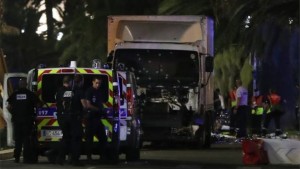
Credit: AFP
Notice that the state of emergency which was due to expire was extended as a result of the attack.
Once again, as with the Paris attacks of last year, Wikipedia has an article up on it almost right away citing 78 references. Someone is “right there” with incredible access to information sources. (httpss://en.wikipedia.org/wiki/2016_Nice_attack) I’d call this propaganda designed to cover a black operation, myself.
In my opinion this operation was almost certainly a false-flag, as the coup attempt in Turkey appears to be as well. I’m certain that none of it will succeed in the ways the perpetrators imagine.
It’s not easy to find news coverage other than the mainstream media so reader discernment is advised.
Nice attack: What we know about the Bastille Day killings
BBC News, July 17, 2016
https://www.bbc.com/news/world-europe-36801671
Dozens of people have been killed, including children, after a lorry ploughed into a large crowd watching a fireworks display marking the end of the French national holiday for Bastille Day.
The driver also fired shots, before being killed by police. This is what we know so far about what happened.
Who is the attacker?
The driver of the lorry has been identified by officials as Mohamed Lahouaiej-Bouhlel, a 31-year-old man of Franco-Tunisian origin.
Paris prosecutor Francois Molins says Lahouaiej-Bouhlel was divorced with three children. His ex-wife was taken into custody on Friday morning along with four other people believed to be linked to him. A flat he lived in near Nice train station was searched by police on Friday morning.
Mr Molins said Lahouaiej-Bouhlel was “totally unknown” to security services, and the investigations are continuing into whether Lahouaiej-Bouhlel acted alone.
He is said to have hired the lorry from a rental company in Saint-Laurent-du-Var, a town to the west of Nice, on 11 July, and had been due to return it on 13 July.
Police said that, at the time of the attack, Lahouaiej-Bouhlel was in possession of an automatic pistol, bullets, a fake automatic pistol and two replica assault rifles (a Kalashnikov and an M16), an empty grenade. Also in the lorry with him were a driving licence and a bank card.
Who were the victims?
At least 84 people were killed, including 10 children and teenagers.
A total of 303 people were taken into hospital following the attacks, the French health department confirmed on Saturday. Of those, 121 remain in hospital, 30 of whom are children, and 26 people are still in intensive care – including five children.
In the hours after the attacks, worried relatives posted images on social media of the missing.
Among the dead was Fatima Charrihi, whose son said she was the first to die.
Another victim, according to reports, was the assistant head of the Nice border police, Jean-Marc Leclerc.
An American 11-year-old boy, Brodie Copeland, and his father, Sean, were also killed. They had been on holiday in Nice.
Three people on a school trip from Germany were unaccounted for.
Who was behind the attack?
French security officials are still assessing whether the driver of a truck was working alone or in a group.
So-called Islamic State later claimed one of its followers carried out the attack.
A news agency linked to the group, Amaq Agency, said: “He did the attack in response to calls to target the citizens of the coalition that is fighting the Islamic State.”
Officials said it bore the hallmark of a terrorist organisation.
President Hollande said on Friday that it was “an attack whose terrorist nature cannot be denied”.
Mr Molins said the attack was “in line with the constant calls to kill” from militant Islamist groups, and the investigation would be seek to find out whether Lahouaiej-Bouhlel had ties to Islamist militants.
French Interior Minister Bernard Cazeneuve said Lahouaiej-Bouhlel seemed to have been “radicalised very quickly”.
Anti-terrorist prosecutors in Paris have launched an inquiry for murder and attempted murder as part of an organised terrorist strike.
Earlier this week, France’s DGSI internal security organisation warned of the danger of further attacks from Islamist militants with “booby-trapped vehicles and bombs”.
The so-called Islamic State has targeted France on several occasions since January 2015.
Only hours before the Nice attack, President Hollande had announced that France’s state of emergency would be removed later this month. After the attack in Nice he announced it was being extended.
Read more: https://www.bbc.com/news/world-europe-36801671

